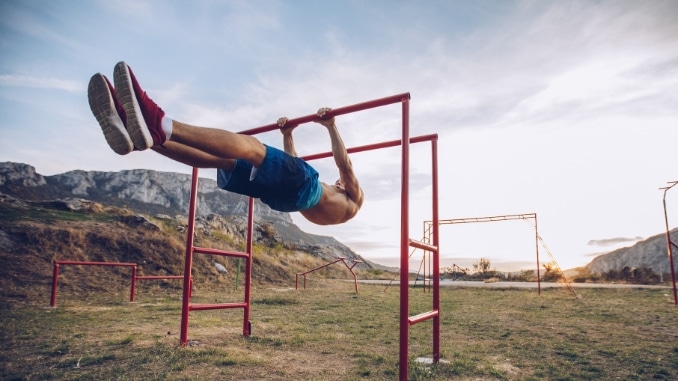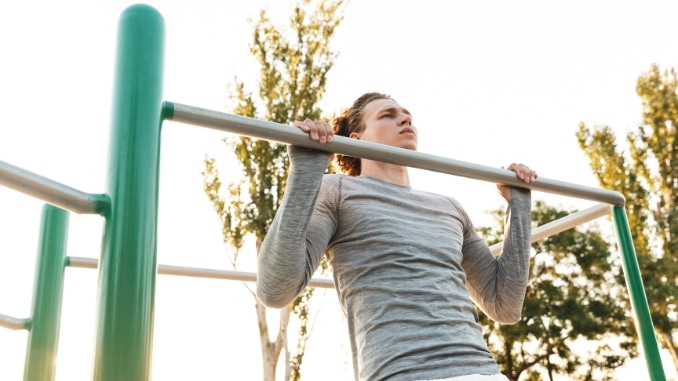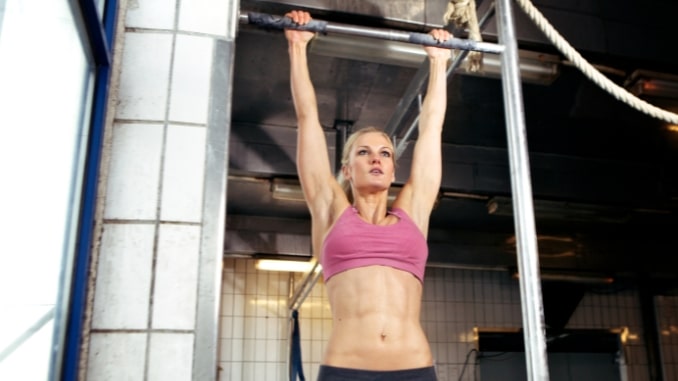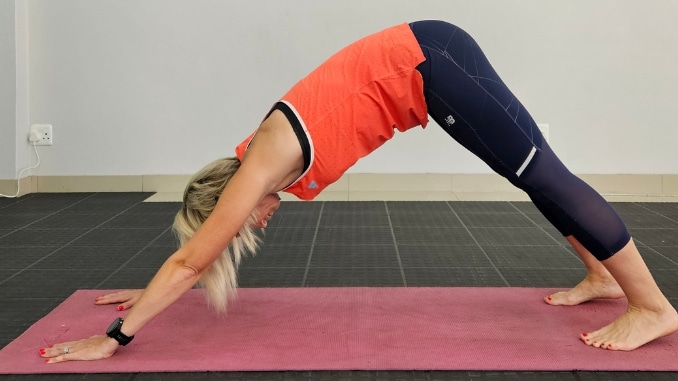A strong back is essential for overall fitness and functionality. It not only improves posture and reduces the risk of back pain, but it also plays a crucial role in many daily activities, such as lifting, pulling, and pushing.
Neglecting your back muscles can lead to imbalances, weakness, and limited performance in other exercises. Calisthenics is a highly effective approach to building a strong back.
Unlike traditional weightlifting exercises that often isolate specific muscles, calisthenics engages multiple muscle groups simultaneously, promoting functional strength and stability.
What is Calisthenics?

Calisthenics is a form of bodyweight exercise that utilizes your body weight as resistance, eliminating the need for equipment or weights.
It is a versatile and accessible form of training that can be done anywhere, making it perfect for individuals who prefer to exercise at home or in outdoor settings.
These bodyweight exercises involve compound movements that engage multiple muscle groups, challenging your strength, coordination, and flexibility.
By mastering your body's movements, calisthenics enables you to develop functional strength and control, enhancing your overall physical performance.
Benefits of Calisthenics for Back
Calisthenics offers multiple benefits [1] for back strength and development:
- Comprehensive Muscle Engagement: It targets key back muscles like the erector spinae, latissimus dorsi, rhomboids, and trapezius, fostering functional strength and a balanced back.
- Improves Posture and Stability: Regular practice strengthens the back, enhances spinal alignment, and boosts stability.
- Enhances Coordination and Control: The compound movements improve overall body coordination and control.
- Adaptable Training: Calisthenics exercises can be adjusted for difficulty, allowing continuous progression, and are suitable for any fitness level.
- Cost-Effective and Convenient: Minimal equipment is required, making it an accessible and affordable option for back training anywhere.
It provides a holistic approach to improving back strength, flexibility, and health.
Calisthenics Back Workout Basics

Before starting a calisthenics back workout, it's crucial to understand the basic principles and structure:
- Warm-up: Properly warming up is essential to prepare your muscles and joints for the exercises.
- Pulling Exercises: These include wide-grip pull-ups, regular pull-ups, chin-ups, and row variations, which target muscles used in pulling movements.
- Pushing Exercises: Push-ups and dips focus on muscles involved in pushing movements.
- Core Exercises: Incorporating core exercises such as planks, bridges, and leg raises strengthens the abdominal and lower back muscles and benefits the upper back.
This structured approach ensures a comprehensive workout that enhances muscle strength and coordination across the back and core.
Warm-up Exercises for your Back
To prevent injury and enhance the effectiveness of your calisthenics back workout, it's crucial to warm up thoroughly:
- Light Cardio: To increase your heart rate and warm up your body, start with 5-10 minutes of light cardio exercises, such as jogging or jumping jacks.
- Dynamic Stretches: To loosen your upper body, continue with dynamic stretches that focus on your back, such as arm circles, shoulder rolls, and torso rotations.
- Activation Exercises: Finish your warm-up with activation exercises for your back muscles, such as the scapular retraction. Stand with arms at your sides, squeeze your shoulder blades together as if holding a pencil between them, hold for a few seconds, and repeat for 10-15 reps.
This structured warm-up increases blood flow improves joint mobility, and activates the muscles, preparing them for the workout ahead.
Calisthenics Back Workout for Beginners
Now that you're warmed up and ready to go, it's time to dive into the dynamic power exercises that will strengthen your back like never before.
1. Pull-ups

Equipment Needed: Pull-up bar or Doorway installed pull-up bar
Begin in an upright standing position under a pull-up bar. Hang from the bar with your arms fully extended, grip it with your hands slightly wider than shoulder-width apart, palms facing away from you. Engage your core and bend your knees; after that, pull yourself up by driving your elbows down towards your hips. Your chin should go over the bar. Hold this position for a couple of seconds. Slowly lower yourself by extending your arms straight to return to the starting position. Repeat for the desired number of repetitions.
2. Negative Pull-ups

Equipment Needed: Pull-up bar and a box or Doorway installed pull-up bar and a stable chair
Begin in an upright standing position under a pull-up bar. Use a box or jump up to hang to the bar with your chin above the bar and your hands slightly wider than shoulder-width apart, palms facing away from you. Engage your core and slowly lower yourself in a controlled manner until your arms are fully extended. Aim for a descent that lasts about 3-5 seconds. Step back onto the box or ground and reset your position. Step back onto the box or ground to return to the starting position. Repeat for the desired number of repetitions.
3. Scapular Shrugs

Equipment Needed: Pull-up bar or Doorway installed pull-up bar
Begin in an upright standing position under a pull-up bar. Hang from the bar with your arms fully extended and your body in a dead hang. Grip it with your hands shoulder-width apart. Engage your core, retract your shoulder blades by pulling them down and together without bending your elbows, and hold the retracted position for a moment. Slowly release and return to the starting position. Repeat for the desired number of repetitions.
4. Australian Pull-ups (Inverted Rows)

Equipment Needed: Low bar or a sturdy table
Position yourself lying face up under the bar. The bar/table should be set at about waist height. Reach up and grip the bar/table with your hands slightly wider than shoulder-width apart, palms facing towards you. Engage your core and Pull your chest towards the bar by bending your elbows and squeezing your shoulder blades together. Hold this position for a couple of seconds. Lower yourself back down with control to the starting position. Repeat for the desired number of repetitions.
5. Plank to Downward Dog
 |
 |
Start in a plank position with your hands under your shoulders, legs extended, and body in a straight line from head to heels. Push your hips up and back, extending your arms and legs to form an inverted V shape with your body. Your heels should move toward the floor, and your head should be between your arms. Hold the position for a couple of seconds. Transition back to the plank position smoothly. Repeat for the desired number of repetitions.
Progression Techniques for Calisthenics Back Workouts
To continuously improve in your calisthenics back workouts, here are effective progression techniques:
- Increase Resistance: Boost the difficulty of exercises by adding a weighted vest, ankle weights, or a resistance band to enhance muscle growth.
- Increase Repetitions: Gradually add more repetitions to each exercise every week until you achieve your desired intensity.
- Decrease Rest Time: Shorten the rest periods between sets to raise workout intensity and push your muscles harder.
- Modify Exercise Variations: Progress to more advanced variations [2] such as one-arm rows or muscle-ups, once you've mastered basic exercises.
Always progress gradually to prevent injury and maintain proper form, adjusting workout intensity based on your body’s feedback.
Sample Calisthenics Back Workout Routine

Now that you have a good understanding of the basic principles and exercises, here is a sample calisthenics back workout routine to get you started:
- Warm-up: Jogging or jumping jacks for 5 minutes, followed by dynamic stretches and scapular retractions.
- Pull-ups: 3 sets of 8-10 repetitions.
- Rows: 3 sets of 10-12 repetitions.
- Australian pull-ups: 3 sets of 8-10 repetitions.
- Superman: holds 3 sets of 15-20 seconds.
- Planks: 3 sets of 30-60 seconds.
- Bridges: 3 sets of 12-15 repetitions.
Remember to rest for 60-90 seconds between sets and focus on maintaining proper form and technique throughout the workout.
Importance of Proper Form and Technique
Maintaining proper form and technique is essential in calisthenics, especially for exercises targeting the back, as incorrect form can reduce effectiveness and increase injury risk.
- Pulling Exercises: For movements like pull-ups and rows, engage your back muscles without relying on momentum or excessive swinging. Keep your core engaged and shoulders back and down.
- Pushing Exercises: In exercises like push-ups or dips, keep your body in a straight line from head to heels, avoiding back arching or hip sagging to ensure effective engagement of back muscles and proper alignment.
If unsure about your form, consider working with a qualified trainer to get the right guidance and feedback. Start with lighter weights or modified exercises, progressing gradually as you master the correct form.
Common Mistakes to Avoid During Calisthenics Back Workouts

To maximize the effectiveness of your calisthenics back workout and minimize the risk of injury, be aware of these common mistakes:
- Neglecting Proper Warm-up: Always warm up thoroughly to prevent muscle strains or pulls and prepare your body for exercise.
- Poor Posture: Maintain correct posture during exercises to target muscles and avoid injury effectively.
- Overtraining: Consistency is crucial, but too much can cause muscle fatigue and injury. Ensure adequate rest and recovery between sessions.
- Sacrificing Form for Quantity: Prioritize correct form over the number of repetitions or sets to prevent imbalances and injuries.
- Not Listening to Your Body: Adapt exercises and take breaks as needed. Ignoring pain or discomfort can worsen injuries and delay progress.
Conclusion: Unleash your Potential with Calisthenics Back Workouts
A strong back is not only aesthetically pleasing but also essential for overall strength, stability, and functionality. Calisthenics offers a highly effective and accessible way to strengthen your back muscles and unleash your full potential.
By incorporating calisthenics exercises such as pull-ups, rows, and planks into your workout routine, you can develop a strong, well-defined back and improve your overall physical performance. Remember to warm up properly, maintain proper form and technique, and gradually progress as you become stronger.
So, whether you are a beginner or an advanced fitness enthusiast, give calisthenics back workouts a try and experience the dynamic power and strength that they provide. Unleash your potential and achieve a stronger, more powerful back like never before!
Strengthening your back can also help correct poor posture, improve your balance, prevent falls and better your quality of life. Don’t wait any longer. It’s time to focus on your back health! Check out this 10 Easy Movements for a Stronger Back now!





